Hospitality Consumer Behaviour: A Case Study of Ritz London Trends
VerifiedAdded on 2023/06/16
|15
|4138
|399
Report
AI Summary
This report provides an in-depth analysis of consumer behaviour and insights within the hospitality industry, using Ritz London as a case study. It investigates cultural, personal, social, and psychological factors influencing consumer behaviour, explores changing consumer trends due to technology, and examines the consumer decision-making journey and path to purchase. The report also compares B2C and B2B decision-making processes in hospitality, evaluates market research approaches, and assesses how marketers can influence and respond to consumer decision-making. The analysis covers need recognition, information search, alternative evaluation, purchase decisions, and post-purchase behaviour, highlighting the importance of customer journey mapping for marketing and customer interaction. Digital technologies' impact on consumer desires and information access is also explored, emphasizing the need for hospitality managers to adapt to evolving consumer expectations.
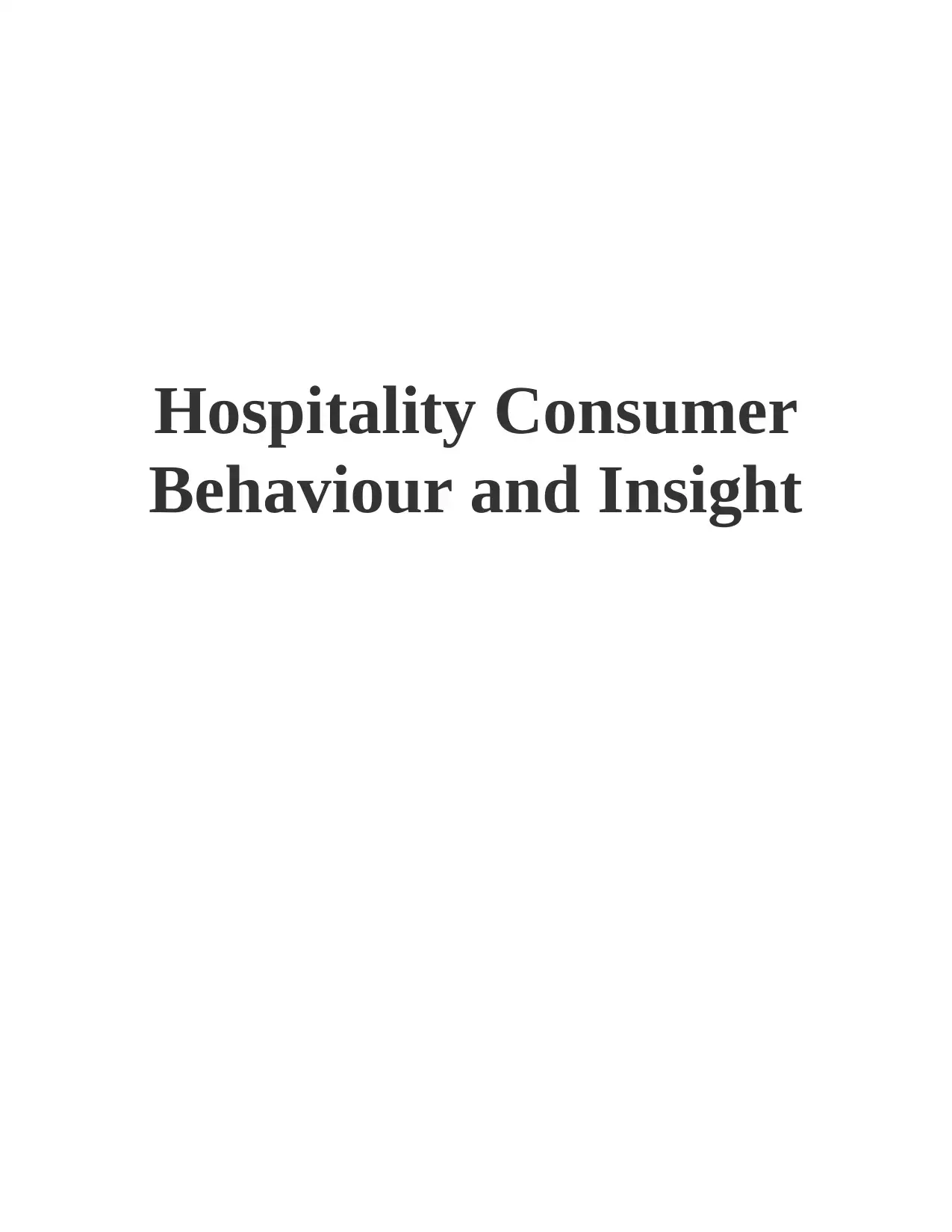
Hospitality Consumer
Behaviour and Insight
Behaviour and Insight
Paraphrase This Document
Need a fresh take? Get an instant paraphrase of this document with our AI Paraphraser
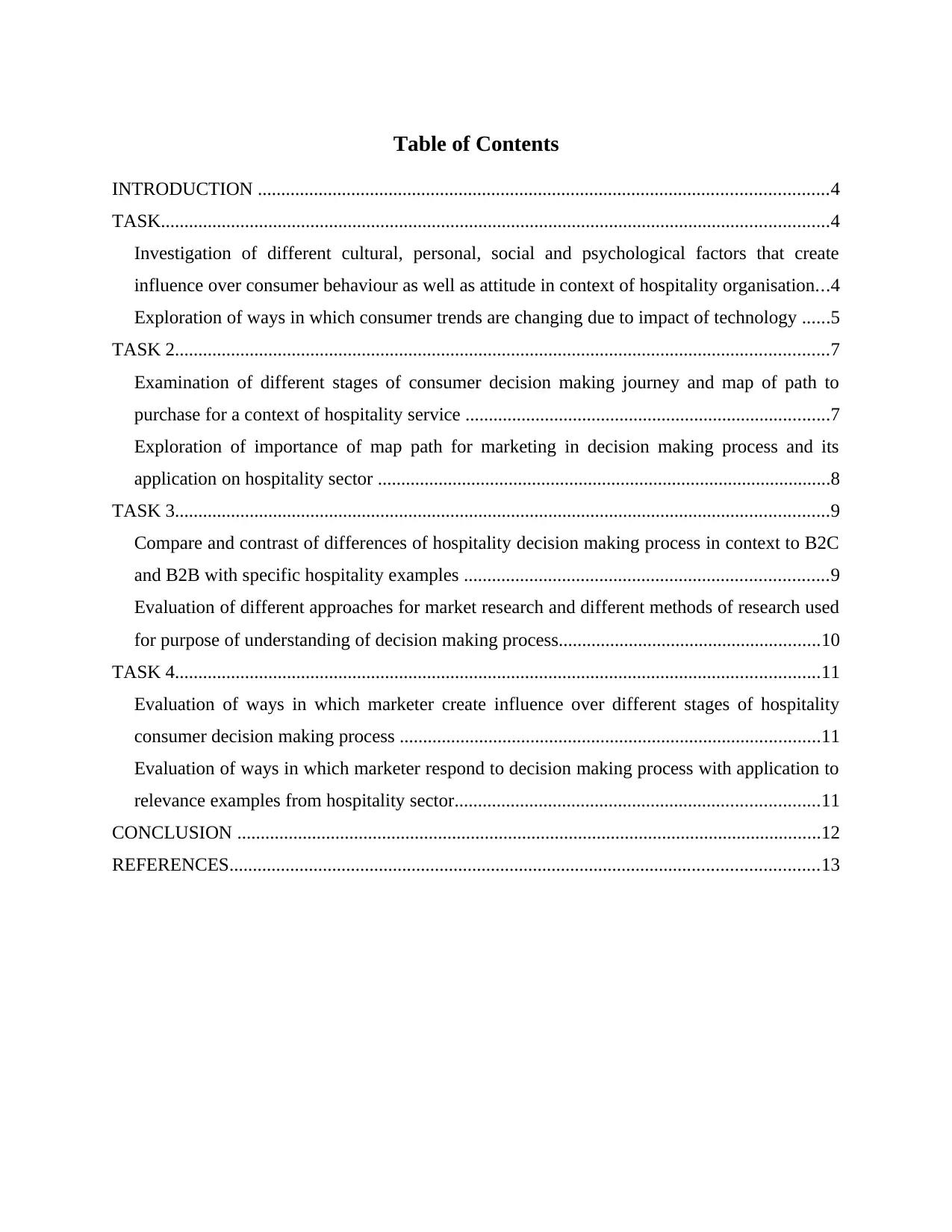
Table of Contents
INTRODUCTION ..........................................................................................................................4
TASK...............................................................................................................................................4
Investigation of different cultural, personal, social and psychological factors that create
influence over consumer behaviour as well as attitude in context of hospitality organisation...4
Exploration of ways in which consumer trends are changing due to impact of technology ......5
TASK 2............................................................................................................................................7
Examination of different stages of consumer decision making journey and map of path to
purchase for a context of hospitality service ..............................................................................7
Exploration of importance of map path for marketing in decision making process and its
application on hospitality sector .................................................................................................8
TASK 3............................................................................................................................................9
Compare and contrast of differences of hospitality decision making process in context to B2C
and B2B with specific hospitality examples ..............................................................................9
Evaluation of different approaches for market research and different methods of research used
for purpose of understanding of decision making process........................................................10
TASK 4..........................................................................................................................................11
Evaluation of ways in which marketer create influence over different stages of hospitality
consumer decision making process ..........................................................................................11
Evaluation of ways in which marketer respond to decision making process with application to
relevance examples from hospitality sector..............................................................................11
CONCLUSION .............................................................................................................................12
REFERENCES..............................................................................................................................13
INTRODUCTION ..........................................................................................................................4
TASK...............................................................................................................................................4
Investigation of different cultural, personal, social and psychological factors that create
influence over consumer behaviour as well as attitude in context of hospitality organisation...4
Exploration of ways in which consumer trends are changing due to impact of technology ......5
TASK 2............................................................................................................................................7
Examination of different stages of consumer decision making journey and map of path to
purchase for a context of hospitality service ..............................................................................7
Exploration of importance of map path for marketing in decision making process and its
application on hospitality sector .................................................................................................8
TASK 3............................................................................................................................................9
Compare and contrast of differences of hospitality decision making process in context to B2C
and B2B with specific hospitality examples ..............................................................................9
Evaluation of different approaches for market research and different methods of research used
for purpose of understanding of decision making process........................................................10
TASK 4..........................................................................................................................................11
Evaluation of ways in which marketer create influence over different stages of hospitality
consumer decision making process ..........................................................................................11
Evaluation of ways in which marketer respond to decision making process with application to
relevance examples from hospitality sector..............................................................................11
CONCLUSION .............................................................................................................................12
REFERENCES..............................................................................................................................13
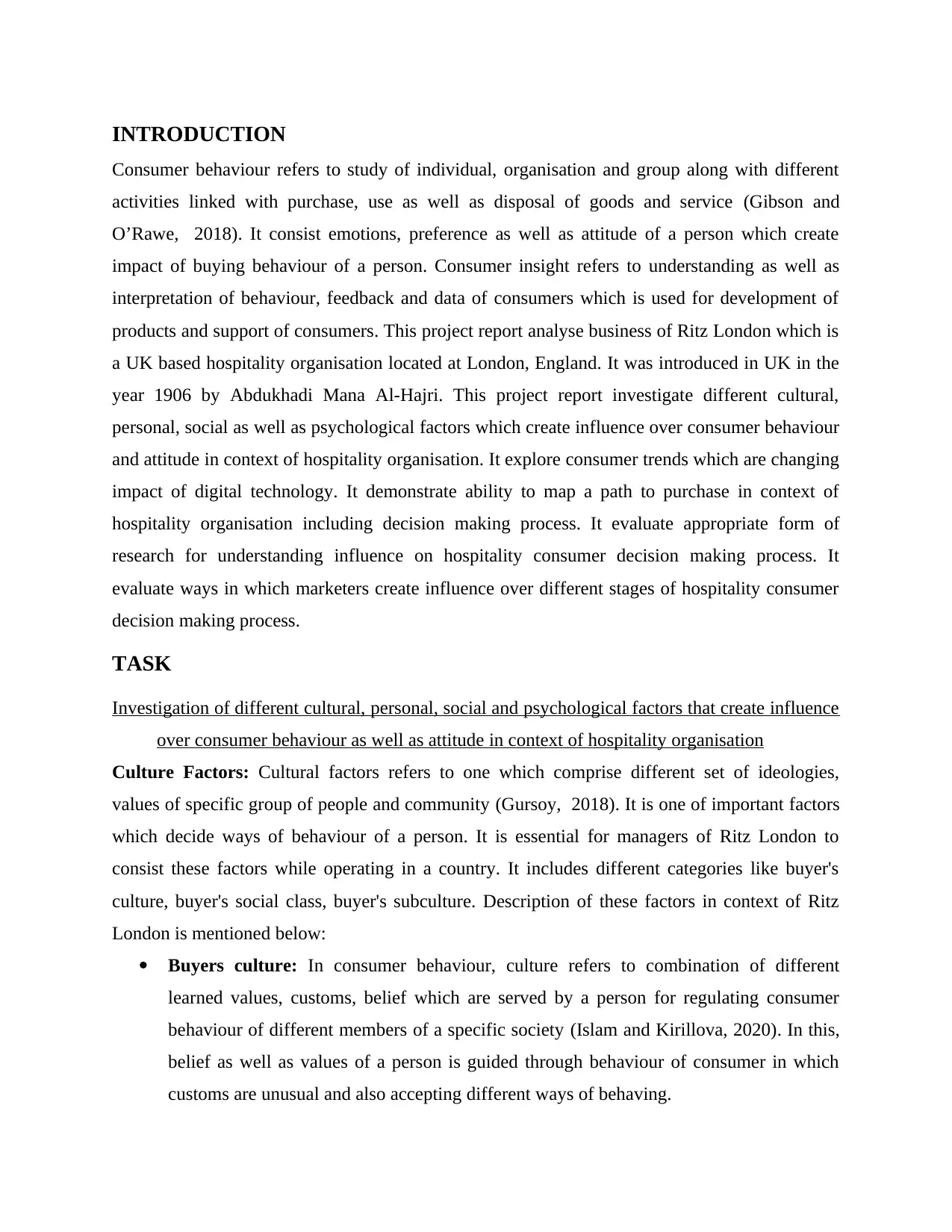
INTRODUCTION
Consumer behaviour refers to study of individual, organisation and group along with different
activities linked with purchase, use as well as disposal of goods and service (Gibson and
O’Rawe, 2018). It consist emotions, preference as well as attitude of a person which create
impact of buying behaviour of a person. Consumer insight refers to understanding as well as
interpretation of behaviour, feedback and data of consumers which is used for development of
products and support of consumers. This project report analyse business of Ritz London which is
a UK based hospitality organisation located at London, England. It was introduced in UK in the
year 1906 by Abdukhadi Mana Al-Hajri. This project report investigate different cultural,
personal, social as well as psychological factors which create influence over consumer behaviour
and attitude in context of hospitality organisation. It explore consumer trends which are changing
impact of digital technology. It demonstrate ability to map a path to purchase in context of
hospitality organisation including decision making process. It evaluate appropriate form of
research for understanding influence on hospitality consumer decision making process. It
evaluate ways in which marketers create influence over different stages of hospitality consumer
decision making process.
TASK
Investigation of different cultural, personal, social and psychological factors that create influence
over consumer behaviour as well as attitude in context of hospitality organisation
Culture Factors: Cultural factors refers to one which comprise different set of ideologies,
values of specific group of people and community (Gursoy, 2018). It is one of important factors
which decide ways of behaviour of a person. It is essential for managers of Ritz London to
consist these factors while operating in a country. It includes different categories like buyer's
culture, buyer's social class, buyer's subculture. Description of these factors in context of Ritz
London is mentioned below:
Buyers culture: In consumer behaviour, culture refers to combination of different
learned values, customs, belief which are served by a person for regulating consumer
behaviour of different members of a specific society (Islam and Kirillova, 2020). In this,
belief as well as values of a person is guided through behaviour of consumer in which
customs are unusual and also accepting different ways of behaving.
Consumer behaviour refers to study of individual, organisation and group along with different
activities linked with purchase, use as well as disposal of goods and service (Gibson and
O’Rawe, 2018). It consist emotions, preference as well as attitude of a person which create
impact of buying behaviour of a person. Consumer insight refers to understanding as well as
interpretation of behaviour, feedback and data of consumers which is used for development of
products and support of consumers. This project report analyse business of Ritz London which is
a UK based hospitality organisation located at London, England. It was introduced in UK in the
year 1906 by Abdukhadi Mana Al-Hajri. This project report investigate different cultural,
personal, social as well as psychological factors which create influence over consumer behaviour
and attitude in context of hospitality organisation. It explore consumer trends which are changing
impact of digital technology. It demonstrate ability to map a path to purchase in context of
hospitality organisation including decision making process. It evaluate appropriate form of
research for understanding influence on hospitality consumer decision making process. It
evaluate ways in which marketers create influence over different stages of hospitality consumer
decision making process.
TASK
Investigation of different cultural, personal, social and psychological factors that create influence
over consumer behaviour as well as attitude in context of hospitality organisation
Culture Factors: Cultural factors refers to one which comprise different set of ideologies,
values of specific group of people and community (Gursoy, 2018). It is one of important factors
which decide ways of behaviour of a person. It is essential for managers of Ritz London to
consist these factors while operating in a country. It includes different categories like buyer's
culture, buyer's social class, buyer's subculture. Description of these factors in context of Ritz
London is mentioned below:
Buyers culture: In consumer behaviour, culture refers to combination of different
learned values, customs, belief which are served by a person for regulating consumer
behaviour of different members of a specific society (Islam and Kirillova, 2020). In this,
belief as well as values of a person is guided through behaviour of consumer in which
customs are unusual and also accepting different ways of behaving.
⊘ This is a preview!⊘
Do you want full access?
Subscribe today to unlock all pages.

Trusted by 1+ million students worldwide
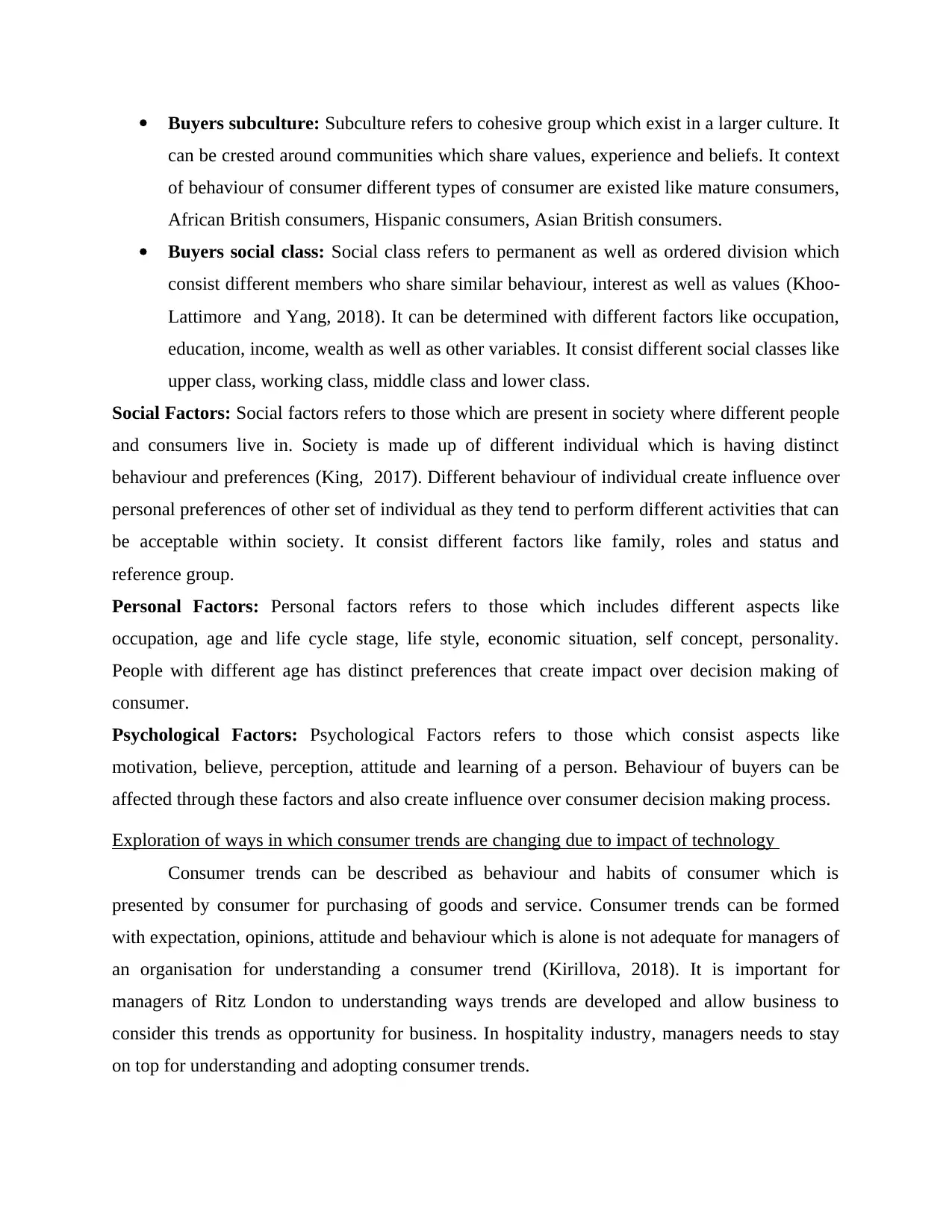
Buyers subculture: Subculture refers to cohesive group which exist in a larger culture. It
can be crested around communities which share values, experience and beliefs. It context
of behaviour of consumer different types of consumer are existed like mature consumers,
African British consumers, Hispanic consumers, Asian British consumers.
Buyers social class: Social class refers to permanent as well as ordered division which
consist different members who share similar behaviour, interest as well as values (Khoo-
Lattimore and Yang, 2018). It can be determined with different factors like occupation,
education, income, wealth as well as other variables. It consist different social classes like
upper class, working class, middle class and lower class.
Social Factors: Social factors refers to those which are present in society where different people
and consumers live in. Society is made up of different individual which is having distinct
behaviour and preferences (King, 2017). Different behaviour of individual create influence over
personal preferences of other set of individual as they tend to perform different activities that can
be acceptable within society. It consist different factors like family, roles and status and
reference group.
Personal Factors: Personal factors refers to those which includes different aspects like
occupation, age and life cycle stage, life style, economic situation, self concept, personality.
People with different age has distinct preferences that create impact over decision making of
consumer.
Psychological Factors: Psychological Factors refers to those which consist aspects like
motivation, believe, perception, attitude and learning of a person. Behaviour of buyers can be
affected through these factors and also create influence over consumer decision making process.
Exploration of ways in which consumer trends are changing due to impact of technology
Consumer trends can be described as behaviour and habits of consumer which is
presented by consumer for purchasing of goods and service. Consumer trends can be formed
with expectation, opinions, attitude and behaviour which is alone is not adequate for managers of
an organisation for understanding a consumer trend (Kirillova, 2018). It is important for
managers of Ritz London to understanding ways trends are developed and allow business to
consider this trends as opportunity for business. In hospitality industry, managers needs to stay
on top for understanding and adopting consumer trends.
can be crested around communities which share values, experience and beliefs. It context
of behaviour of consumer different types of consumer are existed like mature consumers,
African British consumers, Hispanic consumers, Asian British consumers.
Buyers social class: Social class refers to permanent as well as ordered division which
consist different members who share similar behaviour, interest as well as values (Khoo-
Lattimore and Yang, 2018). It can be determined with different factors like occupation,
education, income, wealth as well as other variables. It consist different social classes like
upper class, working class, middle class and lower class.
Social Factors: Social factors refers to those which are present in society where different people
and consumers live in. Society is made up of different individual which is having distinct
behaviour and preferences (King, 2017). Different behaviour of individual create influence over
personal preferences of other set of individual as they tend to perform different activities that can
be acceptable within society. It consist different factors like family, roles and status and
reference group.
Personal Factors: Personal factors refers to those which includes different aspects like
occupation, age and life cycle stage, life style, economic situation, self concept, personality.
People with different age has distinct preferences that create impact over decision making of
consumer.
Psychological Factors: Psychological Factors refers to those which consist aspects like
motivation, believe, perception, attitude and learning of a person. Behaviour of buyers can be
affected through these factors and also create influence over consumer decision making process.
Exploration of ways in which consumer trends are changing due to impact of technology
Consumer trends can be described as behaviour and habits of consumer which is
presented by consumer for purchasing of goods and service. Consumer trends can be formed
with expectation, opinions, attitude and behaviour which is alone is not adequate for managers of
an organisation for understanding a consumer trend (Kirillova, 2018). It is important for
managers of Ritz London to understanding ways trends are developed and allow business to
consider this trends as opportunity for business. In hospitality industry, managers needs to stay
on top for understanding and adopting consumer trends.
Paraphrase This Document
Need a fresh take? Get an instant paraphrase of this document with our AI Paraphraser
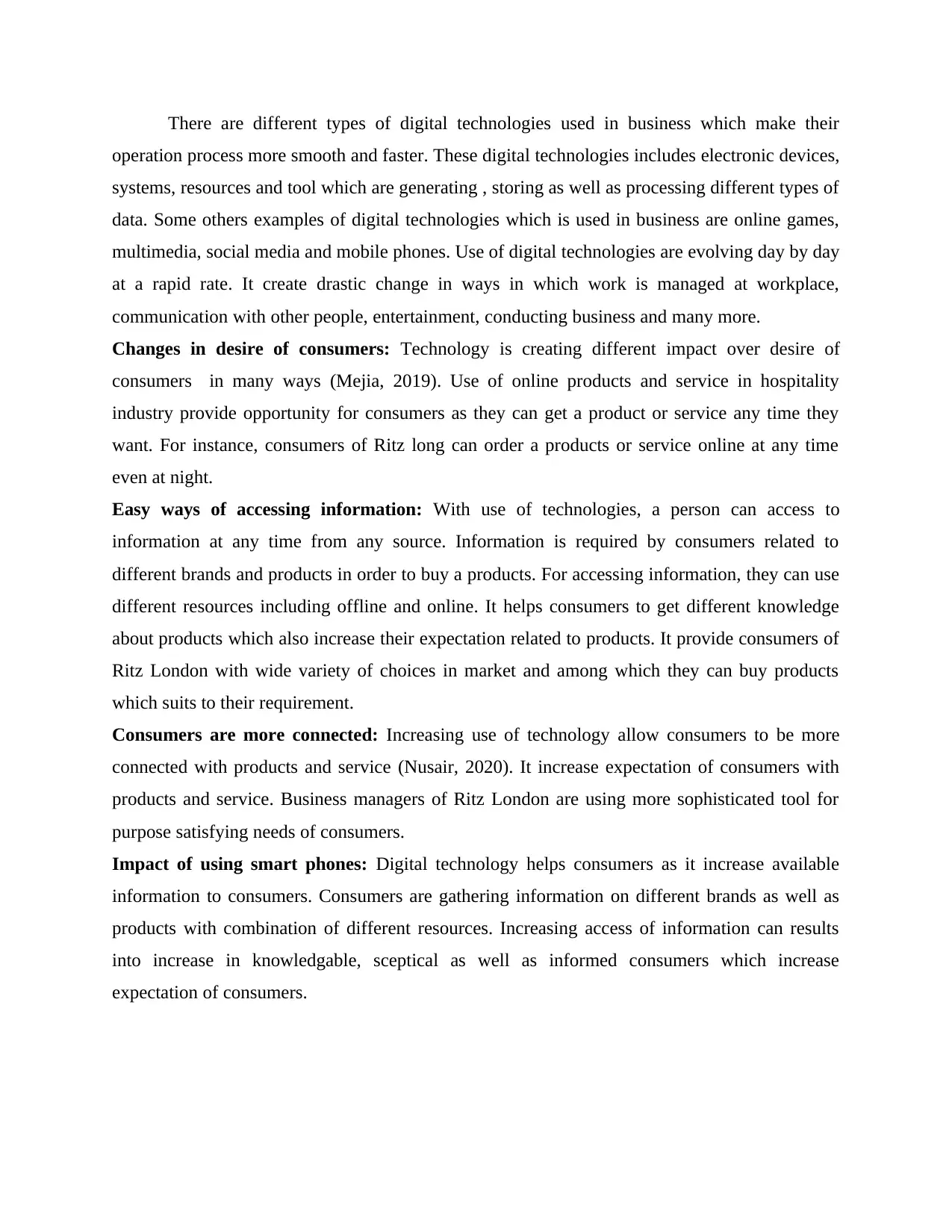
There are different types of digital technologies used in business which make their
operation process more smooth and faster. These digital technologies includes electronic devices,
systems, resources and tool which are generating , storing as well as processing different types of
data. Some others examples of digital technologies which is used in business are online games,
multimedia, social media and mobile phones. Use of digital technologies are evolving day by day
at a rapid rate. It create drastic change in ways in which work is managed at workplace,
communication with other people, entertainment, conducting business and many more.
Changes in desire of consumers: Technology is creating different impact over desire of
consumers in many ways (Mejia, 2019). Use of online products and service in hospitality
industry provide opportunity for consumers as they can get a product or service any time they
want. For instance, consumers of Ritz long can order a products or service online at any time
even at night.
Easy ways of accessing information: With use of technologies, a person can access to
information at any time from any source. Information is required by consumers related to
different brands and products in order to buy a products. For accessing information, they can use
different resources including offline and online. It helps consumers to get different knowledge
about products which also increase their expectation related to products. It provide consumers of
Ritz London with wide variety of choices in market and among which they can buy products
which suits to their requirement.
Consumers are more connected: Increasing use of technology allow consumers to be more
connected with products and service (Nusair, 2020). It increase expectation of consumers with
products and service. Business managers of Ritz London are using more sophisticated tool for
purpose satisfying needs of consumers.
Impact of using smart phones: Digital technology helps consumers as it increase available
information to consumers. Consumers are gathering information on different brands as well as
products with combination of different resources. Increasing access of information can results
into increase in knowledgable, sceptical as well as informed consumers which increase
expectation of consumers.
operation process more smooth and faster. These digital technologies includes electronic devices,
systems, resources and tool which are generating , storing as well as processing different types of
data. Some others examples of digital technologies which is used in business are online games,
multimedia, social media and mobile phones. Use of digital technologies are evolving day by day
at a rapid rate. It create drastic change in ways in which work is managed at workplace,
communication with other people, entertainment, conducting business and many more.
Changes in desire of consumers: Technology is creating different impact over desire of
consumers in many ways (Mejia, 2019). Use of online products and service in hospitality
industry provide opportunity for consumers as they can get a product or service any time they
want. For instance, consumers of Ritz long can order a products or service online at any time
even at night.
Easy ways of accessing information: With use of technologies, a person can access to
information at any time from any source. Information is required by consumers related to
different brands and products in order to buy a products. For accessing information, they can use
different resources including offline and online. It helps consumers to get different knowledge
about products which also increase their expectation related to products. It provide consumers of
Ritz London with wide variety of choices in market and among which they can buy products
which suits to their requirement.
Consumers are more connected: Increasing use of technology allow consumers to be more
connected with products and service (Nusair, 2020). It increase expectation of consumers with
products and service. Business managers of Ritz London are using more sophisticated tool for
purpose satisfying needs of consumers.
Impact of using smart phones: Digital technology helps consumers as it increase available
information to consumers. Consumers are gathering information on different brands as well as
products with combination of different resources. Increasing access of information can results
into increase in knowledgable, sceptical as well as informed consumers which increase
expectation of consumers.
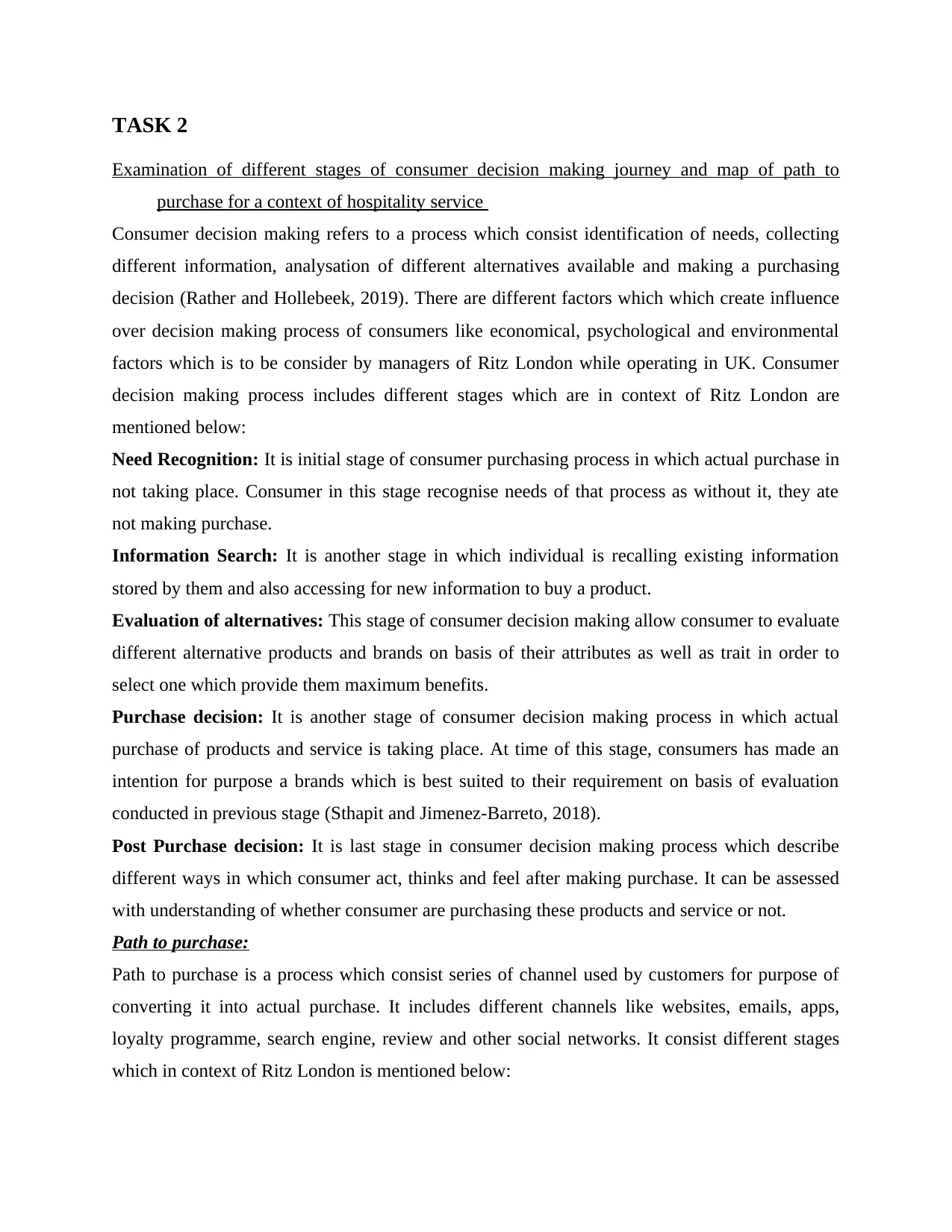
TASK 2
Examination of different stages of consumer decision making journey and map of path to
purchase for a context of hospitality service
Consumer decision making refers to a process which consist identification of needs, collecting
different information, analysation of different alternatives available and making a purchasing
decision (Rather and Hollebeek, 2019). There are different factors which which create influence
over decision making process of consumers like economical, psychological and environmental
factors which is to be consider by managers of Ritz London while operating in UK. Consumer
decision making process includes different stages which are in context of Ritz London are
mentioned below:
Need Recognition: It is initial stage of consumer purchasing process in which actual purchase in
not taking place. Consumer in this stage recognise needs of that process as without it, they ate
not making purchase.
Information Search: It is another stage in which individual is recalling existing information
stored by them and also accessing for new information to buy a product.
Evaluation of alternatives: This stage of consumer decision making allow consumer to evaluate
different alternative products and brands on basis of their attributes as well as trait in order to
select one which provide them maximum benefits.
Purchase decision: It is another stage of consumer decision making process in which actual
purchase of products and service is taking place. At time of this stage, consumers has made an
intention for purpose a brands which is best suited to their requirement on basis of evaluation
conducted in previous stage (Sthapit and Jimenez-Barreto, 2018).
Post Purchase decision: It is last stage in consumer decision making process which describe
different ways in which consumer act, thinks and feel after making purchase. It can be assessed
with understanding of whether consumer are purchasing these products and service or not.
Path to purchase:
Path to purchase is a process which consist series of channel used by customers for purpose of
converting it into actual purchase. It includes different channels like websites, emails, apps,
loyalty programme, search engine, review and other social networks. It consist different stages
which in context of Ritz London is mentioned below:
Examination of different stages of consumer decision making journey and map of path to
purchase for a context of hospitality service
Consumer decision making refers to a process which consist identification of needs, collecting
different information, analysation of different alternatives available and making a purchasing
decision (Rather and Hollebeek, 2019). There are different factors which which create influence
over decision making process of consumers like economical, psychological and environmental
factors which is to be consider by managers of Ritz London while operating in UK. Consumer
decision making process includes different stages which are in context of Ritz London are
mentioned below:
Need Recognition: It is initial stage of consumer purchasing process in which actual purchase in
not taking place. Consumer in this stage recognise needs of that process as without it, they ate
not making purchase.
Information Search: It is another stage in which individual is recalling existing information
stored by them and also accessing for new information to buy a product.
Evaluation of alternatives: This stage of consumer decision making allow consumer to evaluate
different alternative products and brands on basis of their attributes as well as trait in order to
select one which provide them maximum benefits.
Purchase decision: It is another stage of consumer decision making process in which actual
purchase of products and service is taking place. At time of this stage, consumers has made an
intention for purpose a brands which is best suited to their requirement on basis of evaluation
conducted in previous stage (Sthapit and Jimenez-Barreto, 2018).
Post Purchase decision: It is last stage in consumer decision making process which describe
different ways in which consumer act, thinks and feel after making purchase. It can be assessed
with understanding of whether consumer are purchasing these products and service or not.
Path to purchase:
Path to purchase is a process which consist series of channel used by customers for purpose of
converting it into actual purchase. It includes different channels like websites, emails, apps,
loyalty programme, search engine, review and other social networks. It consist different stages
which in context of Ritz London is mentioned below:
⊘ This is a preview!⊘
Do you want full access?
Subscribe today to unlock all pages.

Trusted by 1+ million students worldwide
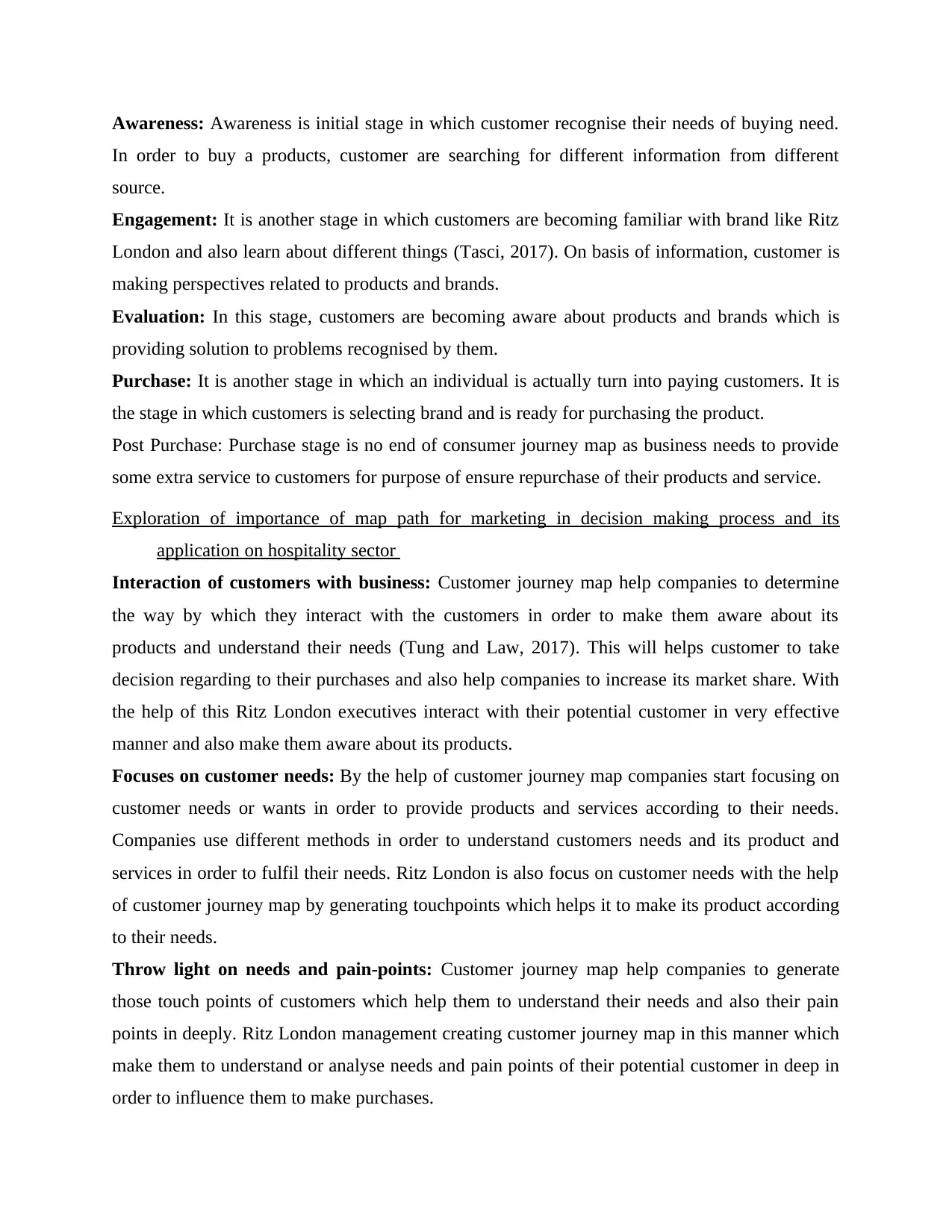
Awareness: Awareness is initial stage in which customer recognise their needs of buying need.
In order to buy a products, customer are searching for different information from different
source.
Engagement: It is another stage in which customers are becoming familiar with brand like Ritz
London and also learn about different things (Tasci, 2017). On basis of information, customer is
making perspectives related to products and brands.
Evaluation: In this stage, customers are becoming aware about products and brands which is
providing solution to problems recognised by them.
Purchase: It is another stage in which an individual is actually turn into paying customers. It is
the stage in which customers is selecting brand and is ready for purchasing the product.
Post Purchase: Purchase stage is no end of consumer journey map as business needs to provide
some extra service to customers for purpose of ensure repurchase of their products and service.
Exploration of importance of map path for marketing in decision making process and its
application on hospitality sector
Interaction of customers with business: Customer journey map help companies to determine
the way by which they interact with the customers in order to make them aware about its
products and understand their needs (Tung and Law, 2017). This will helps customer to take
decision regarding to their purchases and also help companies to increase its market share. With
the help of this Ritz London executives interact with their potential customer in very effective
manner and also make them aware about its products.
Focuses on customer needs: By the help of customer journey map companies start focusing on
customer needs or wants in order to provide products and services according to their needs.
Companies use different methods in order to understand customers needs and its product and
services in order to fulfil their needs. Ritz London is also focus on customer needs with the help
of customer journey map by generating touchpoints which helps it to make its product according
to their needs.
Throw light on needs and pain-points: Customer journey map help companies to generate
those touch points of customers which help them to understand their needs and also their pain
points in deeply. Ritz London management creating customer journey map in this manner which
make them to understand or analyse needs and pain points of their potential customer in deep in
order to influence them to make purchases.
In order to buy a products, customer are searching for different information from different
source.
Engagement: It is another stage in which customers are becoming familiar with brand like Ritz
London and also learn about different things (Tasci, 2017). On basis of information, customer is
making perspectives related to products and brands.
Evaluation: In this stage, customers are becoming aware about products and brands which is
providing solution to problems recognised by them.
Purchase: It is another stage in which an individual is actually turn into paying customers. It is
the stage in which customers is selecting brand and is ready for purchasing the product.
Post Purchase: Purchase stage is no end of consumer journey map as business needs to provide
some extra service to customers for purpose of ensure repurchase of their products and service.
Exploration of importance of map path for marketing in decision making process and its
application on hospitality sector
Interaction of customers with business: Customer journey map help companies to determine
the way by which they interact with the customers in order to make them aware about its
products and understand their needs (Tung and Law, 2017). This will helps customer to take
decision regarding to their purchases and also help companies to increase its market share. With
the help of this Ritz London executives interact with their potential customer in very effective
manner and also make them aware about its products.
Focuses on customer needs: By the help of customer journey map companies start focusing on
customer needs or wants in order to provide products and services according to their needs.
Companies use different methods in order to understand customers needs and its product and
services in order to fulfil their needs. Ritz London is also focus on customer needs with the help
of customer journey map by generating touchpoints which helps it to make its product according
to their needs.
Throw light on needs and pain-points: Customer journey map help companies to generate
those touch points of customers which help them to understand their needs and also their pain
points in deeply. Ritz London management creating customer journey map in this manner which
make them to understand or analyse needs and pain points of their potential customer in deep in
order to influence them to make purchases.
Paraphrase This Document
Need a fresh take? Get an instant paraphrase of this document with our AI Paraphraser
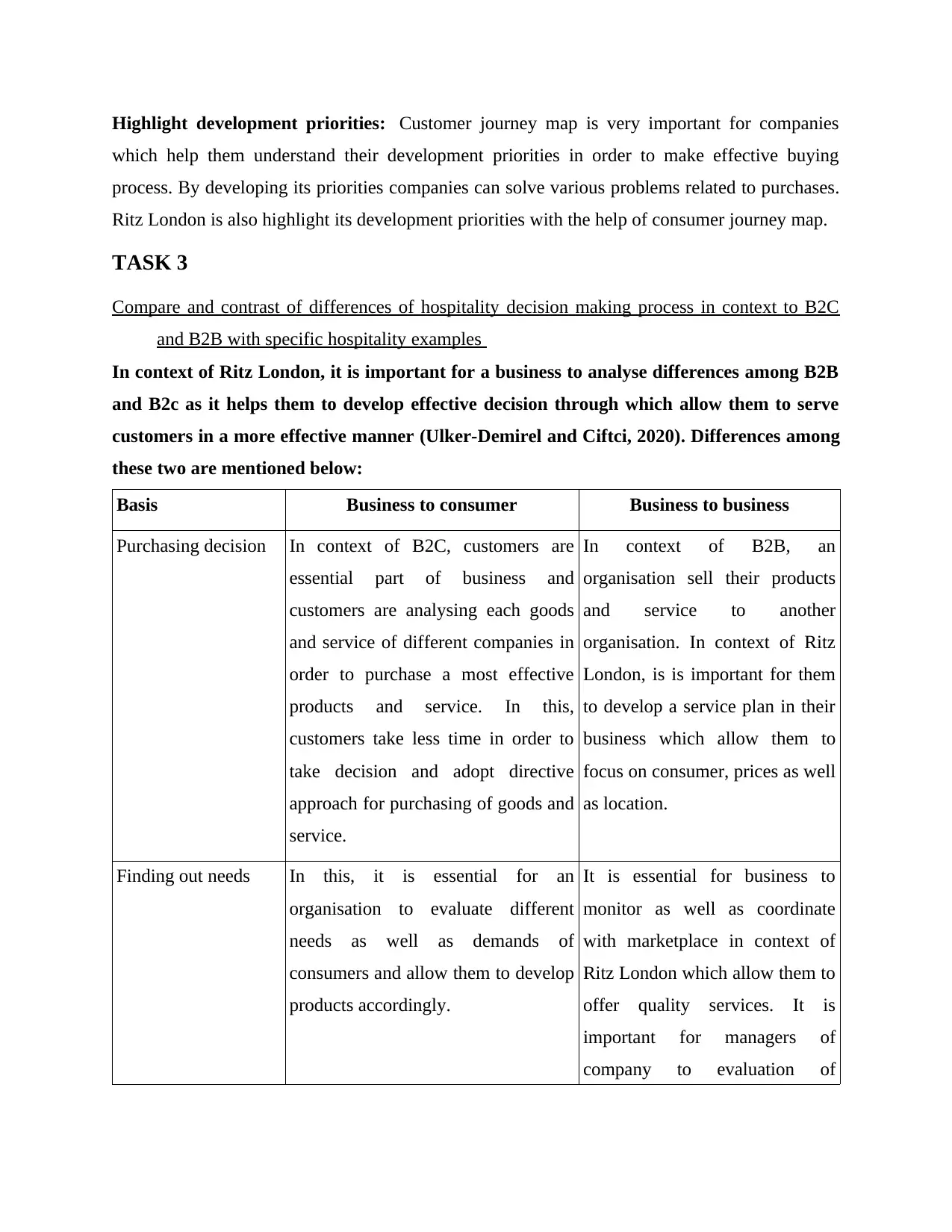
Highlight development priorities: Customer journey map is very important for companies
which help them understand their development priorities in order to make effective buying
process. By developing its priorities companies can solve various problems related to purchases.
Ritz London is also highlight its development priorities with the help of consumer journey map.
TASK 3
Compare and contrast of differences of hospitality decision making process in context to B2C
and B2B with specific hospitality examples
In context of Ritz London, it is important for a business to analyse differences among B2B
and B2c as it helps them to develop effective decision through which allow them to serve
customers in a more effective manner (Ulker-Demirel and Ciftci, 2020). Differences among
these two are mentioned below:
Basis Business to consumer Business to business
Purchasing decision In context of B2C, customers are
essential part of business and
customers are analysing each goods
and service of different companies in
order to purchase a most effective
products and service. In this,
customers take less time in order to
take decision and adopt directive
approach for purchasing of goods and
service.
In context of B2B, an
organisation sell their products
and service to another
organisation. In context of Ritz
London, is is important for them
to develop a service plan in their
business which allow them to
focus on consumer, prices as well
as location.
Finding out needs In this, it is essential for an
organisation to evaluate different
needs as well as demands of
consumers and allow them to develop
products accordingly.
It is essential for business to
monitor as well as coordinate
with marketplace in context of
Ritz London which allow them to
offer quality services. It is
important for managers of
company to evaluation of
which help them understand their development priorities in order to make effective buying
process. By developing its priorities companies can solve various problems related to purchases.
Ritz London is also highlight its development priorities with the help of consumer journey map.
TASK 3
Compare and contrast of differences of hospitality decision making process in context to B2C
and B2B with specific hospitality examples
In context of Ritz London, it is important for a business to analyse differences among B2B
and B2c as it helps them to develop effective decision through which allow them to serve
customers in a more effective manner (Ulker-Demirel and Ciftci, 2020). Differences among
these two are mentioned below:
Basis Business to consumer Business to business
Purchasing decision In context of B2C, customers are
essential part of business and
customers are analysing each goods
and service of different companies in
order to purchase a most effective
products and service. In this,
customers take less time in order to
take decision and adopt directive
approach for purchasing of goods and
service.
In context of B2B, an
organisation sell their products
and service to another
organisation. In context of Ritz
London, is is important for them
to develop a service plan in their
business which allow them to
focus on consumer, prices as well
as location.
Finding out needs In this, it is essential for an
organisation to evaluate different
needs as well as demands of
consumers and allow them to develop
products accordingly.
It is essential for business to
monitor as well as coordinate
with marketplace in context of
Ritz London which allow them to
offer quality services. It is
important for managers of
company to evaluation of
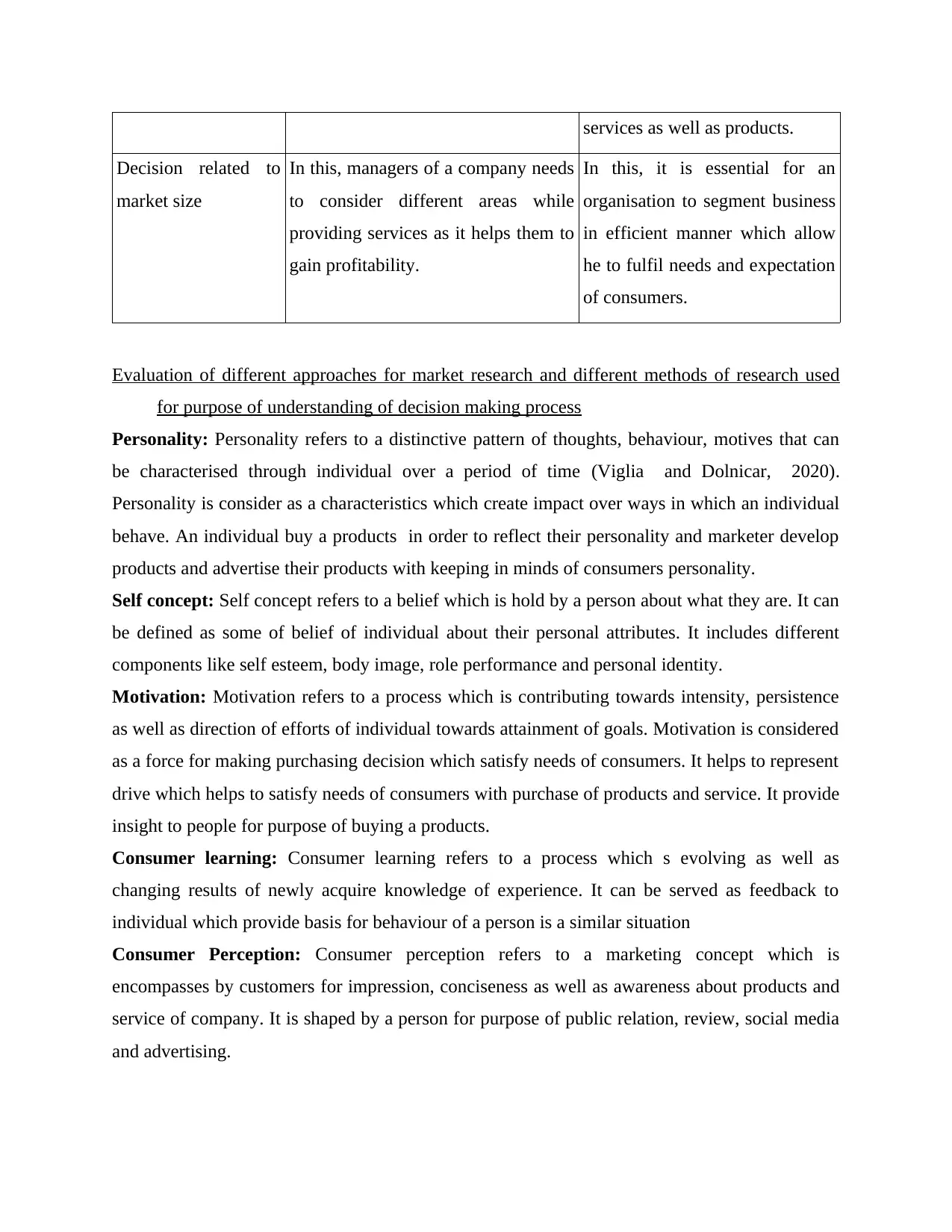
services as well as products.
Decision related to
market size
In this, managers of a company needs
to consider different areas while
providing services as it helps them to
gain profitability.
In this, it is essential for an
organisation to segment business
in efficient manner which allow
he to fulfil needs and expectation
of consumers.
Evaluation of different approaches for market research and different methods of research used
for purpose of understanding of decision making process
Personality: Personality refers to a distinctive pattern of thoughts, behaviour, motives that can
be characterised through individual over a period of time (Viglia and Dolnicar, 2020).
Personality is consider as a characteristics which create impact over ways in which an individual
behave. An individual buy a products in order to reflect their personality and marketer develop
products and advertise their products with keeping in minds of consumers personality.
Self concept: Self concept refers to a belief which is hold by a person about what they are. It can
be defined as some of belief of individual about their personal attributes. It includes different
components like self esteem, body image, role performance and personal identity.
Motivation: Motivation refers to a process which is contributing towards intensity, persistence
as well as direction of efforts of individual towards attainment of goals. Motivation is considered
as a force for making purchasing decision which satisfy needs of consumers. It helps to represent
drive which helps to satisfy needs of consumers with purchase of products and service. It provide
insight to people for purpose of buying a products.
Consumer learning: Consumer learning refers to a process which s evolving as well as
changing results of newly acquire knowledge of experience. It can be served as feedback to
individual which provide basis for behaviour of a person is a similar situation
Consumer Perception: Consumer perception refers to a marketing concept which is
encompasses by customers for impression, conciseness as well as awareness about products and
service of company. It is shaped by a person for purpose of public relation, review, social media
and advertising.
Decision related to
market size
In this, managers of a company needs
to consider different areas while
providing services as it helps them to
gain profitability.
In this, it is essential for an
organisation to segment business
in efficient manner which allow
he to fulfil needs and expectation
of consumers.
Evaluation of different approaches for market research and different methods of research used
for purpose of understanding of decision making process
Personality: Personality refers to a distinctive pattern of thoughts, behaviour, motives that can
be characterised through individual over a period of time (Viglia and Dolnicar, 2020).
Personality is consider as a characteristics which create impact over ways in which an individual
behave. An individual buy a products in order to reflect their personality and marketer develop
products and advertise their products with keeping in minds of consumers personality.
Self concept: Self concept refers to a belief which is hold by a person about what they are. It can
be defined as some of belief of individual about their personal attributes. It includes different
components like self esteem, body image, role performance and personal identity.
Motivation: Motivation refers to a process which is contributing towards intensity, persistence
as well as direction of efforts of individual towards attainment of goals. Motivation is considered
as a force for making purchasing decision which satisfy needs of consumers. It helps to represent
drive which helps to satisfy needs of consumers with purchase of products and service. It provide
insight to people for purpose of buying a products.
Consumer learning: Consumer learning refers to a process which s evolving as well as
changing results of newly acquire knowledge of experience. It can be served as feedback to
individual which provide basis for behaviour of a person is a similar situation
Consumer Perception: Consumer perception refers to a marketing concept which is
encompasses by customers for impression, conciseness as well as awareness about products and
service of company. It is shaped by a person for purpose of public relation, review, social media
and advertising.
⊘ This is a preview!⊘
Do you want full access?
Subscribe today to unlock all pages.

Trusted by 1+ million students worldwide
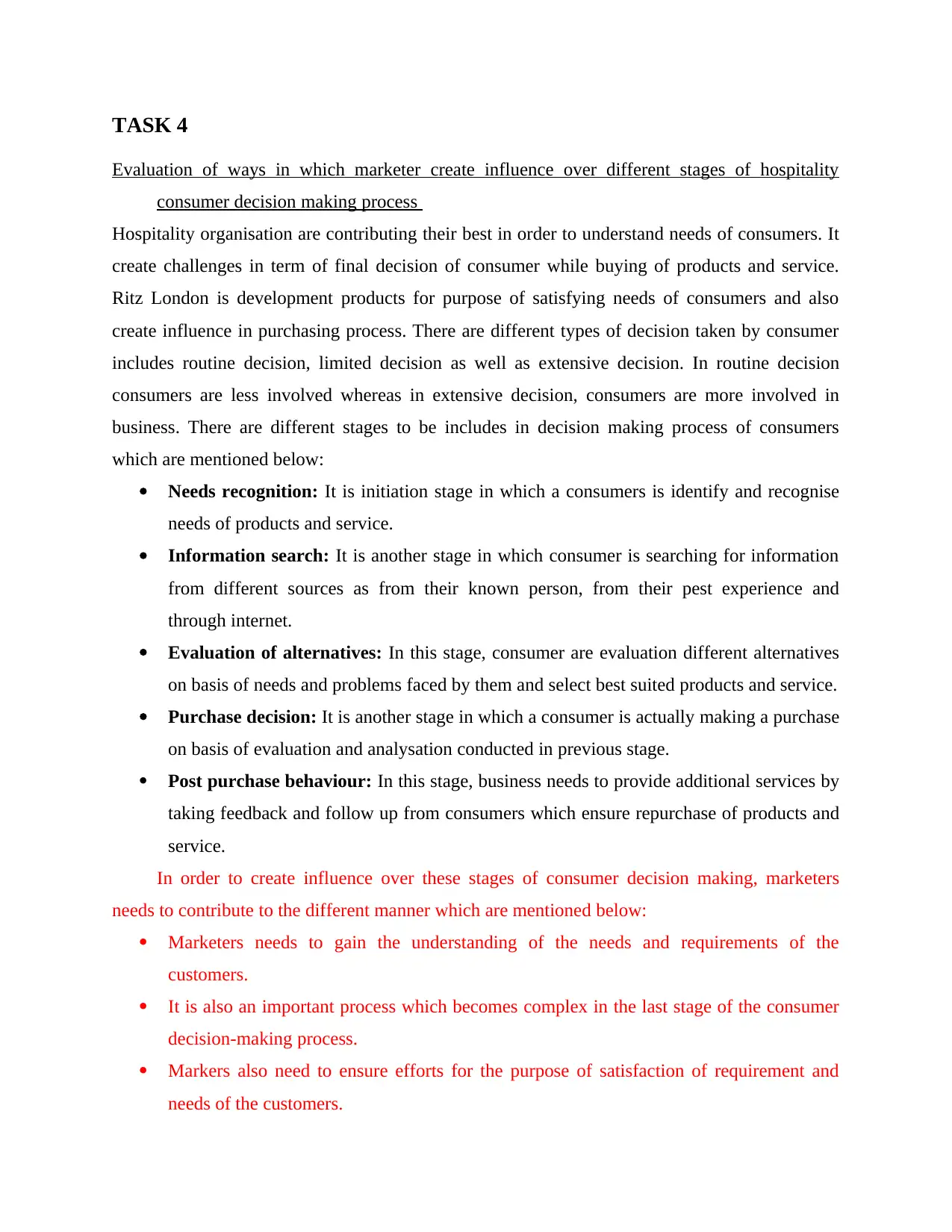
TASK 4
Evaluation of ways in which marketer create influence over different stages of hospitality
consumer decision making process
Hospitality organisation are contributing their best in order to understand needs of consumers. It
create challenges in term of final decision of consumer while buying of products and service.
Ritz London is development products for purpose of satisfying needs of consumers and also
create influence in purchasing process. There are different types of decision taken by consumer
includes routine decision, limited decision as well as extensive decision. In routine decision
consumers are less involved whereas in extensive decision, consumers are more involved in
business. There are different stages to be includes in decision making process of consumers
which are mentioned below:
Needs recognition: It is initiation stage in which a consumers is identify and recognise
needs of products and service.
Information search: It is another stage in which consumer is searching for information
from different sources as from their known person, from their pest experience and
through internet.
Evaluation of alternatives: In this stage, consumer are evaluation different alternatives
on basis of needs and problems faced by them and select best suited products and service.
Purchase decision: It is another stage in which a consumer is actually making a purchase
on basis of evaluation and analysation conducted in previous stage.
Post purchase behaviour: In this stage, business needs to provide additional services by
taking feedback and follow up from consumers which ensure repurchase of products and
service.
In order to create influence over these stages of consumer decision making, marketers
needs to contribute to the different manner which are mentioned below:
Marketers needs to gain the understanding of the needs and requirements of the
customers.
It is also an important process which becomes complex in the last stage of the consumer
decision-making process.
Markers also need to ensure efforts for the purpose of satisfaction of requirement and
needs of the customers.
Evaluation of ways in which marketer create influence over different stages of hospitality
consumer decision making process
Hospitality organisation are contributing their best in order to understand needs of consumers. It
create challenges in term of final decision of consumer while buying of products and service.
Ritz London is development products for purpose of satisfying needs of consumers and also
create influence in purchasing process. There are different types of decision taken by consumer
includes routine decision, limited decision as well as extensive decision. In routine decision
consumers are less involved whereas in extensive decision, consumers are more involved in
business. There are different stages to be includes in decision making process of consumers
which are mentioned below:
Needs recognition: It is initiation stage in which a consumers is identify and recognise
needs of products and service.
Information search: It is another stage in which consumer is searching for information
from different sources as from their known person, from their pest experience and
through internet.
Evaluation of alternatives: In this stage, consumer are evaluation different alternatives
on basis of needs and problems faced by them and select best suited products and service.
Purchase decision: It is another stage in which a consumer is actually making a purchase
on basis of evaluation and analysation conducted in previous stage.
Post purchase behaviour: In this stage, business needs to provide additional services by
taking feedback and follow up from consumers which ensure repurchase of products and
service.
In order to create influence over these stages of consumer decision making, marketers
needs to contribute to the different manner which are mentioned below:
Marketers needs to gain the understanding of the needs and requirements of the
customers.
It is also an important process which becomes complex in the last stage of the consumer
decision-making process.
Markers also need to ensure efforts for the purpose of satisfaction of requirement and
needs of the customers.
Paraphrase This Document
Need a fresh take? Get an instant paraphrase of this document with our AI Paraphraser
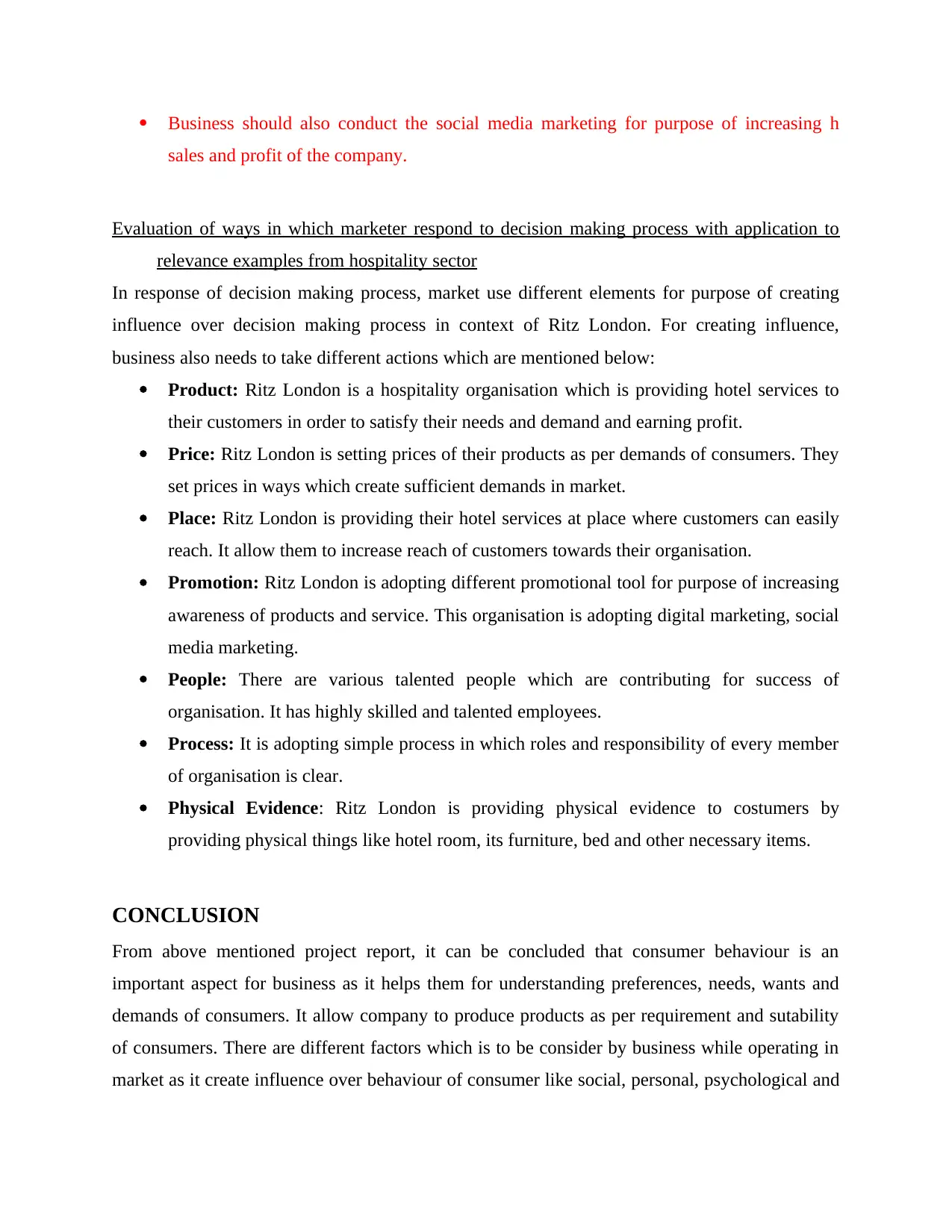
Business should also conduct the social media marketing for purpose of increasing h
sales and profit of the company.
Evaluation of ways in which marketer respond to decision making process with application to
relevance examples from hospitality sector
In response of decision making process, market use different elements for purpose of creating
influence over decision making process in context of Ritz London. For creating influence,
business also needs to take different actions which are mentioned below:
Product: Ritz London is a hospitality organisation which is providing hotel services to
their customers in order to satisfy their needs and demand and earning profit.
Price: Ritz London is setting prices of their products as per demands of consumers. They
set prices in ways which create sufficient demands in market.
Place: Ritz London is providing their hotel services at place where customers can easily
reach. It allow them to increase reach of customers towards their organisation.
Promotion: Ritz London is adopting different promotional tool for purpose of increasing
awareness of products and service. This organisation is adopting digital marketing, social
media marketing.
People: There are various talented people which are contributing for success of
organisation. It has highly skilled and talented employees.
Process: It is adopting simple process in which roles and responsibility of every member
of organisation is clear.
Physical Evidence: Ritz London is providing physical evidence to costumers by
providing physical things like hotel room, its furniture, bed and other necessary items.
CONCLUSION
From above mentioned project report, it can be concluded that consumer behaviour is an
important aspect for business as it helps them for understanding preferences, needs, wants and
demands of consumers. It allow company to produce products as per requirement and sutability
of consumers. There are different factors which is to be consider by business while operating in
market as it create influence over behaviour of consumer like social, personal, psychological and
sales and profit of the company.
Evaluation of ways in which marketer respond to decision making process with application to
relevance examples from hospitality sector
In response of decision making process, market use different elements for purpose of creating
influence over decision making process in context of Ritz London. For creating influence,
business also needs to take different actions which are mentioned below:
Product: Ritz London is a hospitality organisation which is providing hotel services to
their customers in order to satisfy their needs and demand and earning profit.
Price: Ritz London is setting prices of their products as per demands of consumers. They
set prices in ways which create sufficient demands in market.
Place: Ritz London is providing their hotel services at place where customers can easily
reach. It allow them to increase reach of customers towards their organisation.
Promotion: Ritz London is adopting different promotional tool for purpose of increasing
awareness of products and service. This organisation is adopting digital marketing, social
media marketing.
People: There are various talented people which are contributing for success of
organisation. It has highly skilled and talented employees.
Process: It is adopting simple process in which roles and responsibility of every member
of organisation is clear.
Physical Evidence: Ritz London is providing physical evidence to costumers by
providing physical things like hotel room, its furniture, bed and other necessary items.
CONCLUSION
From above mentioned project report, it can be concluded that consumer behaviour is an
important aspect for business as it helps them for understanding preferences, needs, wants and
demands of consumers. It allow company to produce products as per requirement and sutability
of consumers. There are different factors which is to be consider by business while operating in
market as it create influence over behaviour of consumer like social, personal, psychological and

cultural factors. Technology helps business in many ways and also contributing for changing in
consumer trends in market. There are different stages which is to be consider by consumers
while making a purchase like recognition of needs, finding information, evaluation of
alternatives, purchase and post purchase stages.
consumer trends in market. There are different stages which is to be consider by consumers
while making a purchase like recognition of needs, finding information, evaluation of
alternatives, purchase and post purchase stages.
⊘ This is a preview!⊘
Do you want full access?
Subscribe today to unlock all pages.

Trusted by 1+ million students worldwide
1 out of 15
Related Documents
Your All-in-One AI-Powered Toolkit for Academic Success.
+13062052269
info@desklib.com
Available 24*7 on WhatsApp / Email
![[object Object]](/_next/static/media/star-bottom.7253800d.svg)
Unlock your academic potential
Copyright © 2020–2025 A2Z Services. All Rights Reserved. Developed and managed by ZUCOL.



